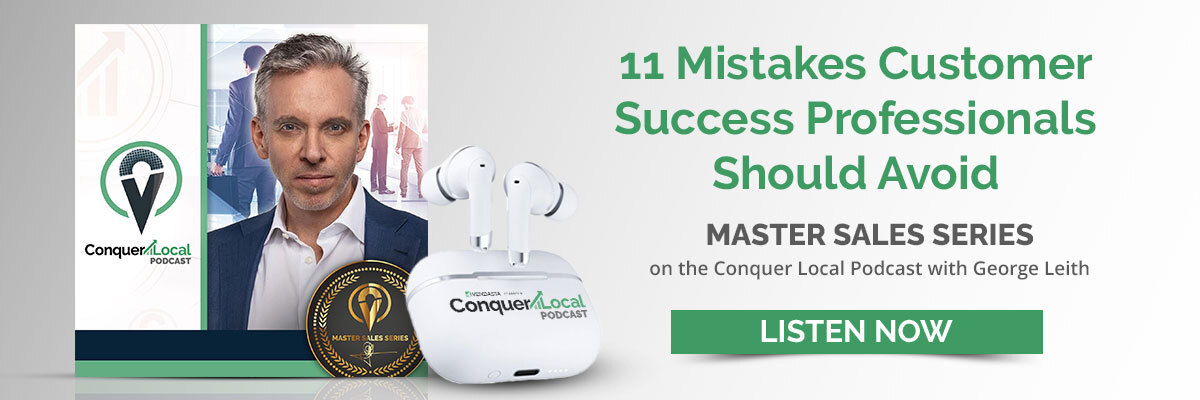Research shows 86 percent of buyers will pay for a better customer experience and it is a purchase consideration that overtakes price and product features as the key brand differentiator, according to SmartKarrot. Keep the customers you already have and attract more through positive referral by avoiding critical mistakes that will risk losing you clients, and your reputation.
Here are the 11 mistakes that customer success and service professionals should avoid for an improved customer experience and to reduce client churn.
1. Not Actively Listening to the Client
Active listening or being attentive and engaged when someone speaks is the most critical factor in the success of any customer interaction. Ditch the idea of completing a check-list of essential areas you want to cover off, and instead focus intently on what your prospect or customer is saying and tune into cues given as your conversation progresses for an improved customer experience.

2. Poor Discovery
Arguably the biggest mistake made in customer service is to not ask questions. Take a look at these sample questions you should use to dig into every interaction:
- What are your biggest challenges?
- What can my company do to better serve your needs?
- How satisfied are you with our products/services?
- What value do we provide?
- Why did you choose us over the competition?
While working with a partner recently, we were looking at the functionality for adding an account, salespeople, and products. The partner was trying to add her salespeople as if they were accounts, which was confusing to me. When asked why she wanted to do this, I uncovered her actual needs. Her team members can be booked by their customers for coaching sessions, and so team members are also a product.
“It would have been easy for me to say, ‘No, your salespeople are not accounts, add them as salespeople’ then move on. But instead, by digging deeper, we were able to develop a plan to instead add them as salespeople and as products, and use our automations within the platform to set up a workflow that helps notify those people whenever someone has bought consulting time with them. It was really exciting,” Schultz says.
3. Spinning the Truth
If your company has made a mistake, be honest and admit to it. If a product or service has not lived up to its expectations, be honest about it. I like to call it “owning your crap.”
With a huge amount of reviews and research available, clients are well educated on the products they buy. They can see right through a fake answer or misleading communication. Don’t deflect, spin, or lie - just tell the truth, own the mistake, and seek a resolution for an improved customer experience.
4. Not Being Friendly
Research shows 58% of American consumers will switch brands because of poor customer service. Customer success professionals must be engaged and show they love their job in order to provide an improved customer experience.
“When a customer connects, they might be your 20th of the day, but you're their first point of contact. It's important to make that experience special for them, treat them with kindness, a smile on your face and use a happy tone of voice each and every time,” F. David Schultz says.
When a client reaches out, they are most often dealing with a challenge. Show you care and bring a positive attitude. Reassure the client you are the one who can solve their problem.
5. Not Saying Sorry
Did you know only 37 percent of upset customers say they were satisfied when offered something in return for reaching out with a customer complaint? However, if the business said sorry too, satisfaction increased to 74 percent.
Few things are worse in the eyes of a customer than a refusal to acknowledge an error. Just say, “sorry.” Apologize even though it’s not your fault. The client is reaching out because their experience did not meet expectations. Apologies can go a long way towards gaining trust back.
Apologies can also help retain that customer for the future. A simple, “I’m sorry” will leave a customer feeling validated and heard.
6. Absence of Ownership
The support team acts as an internal advocate for partners in the organization. We're here to help throughout their entire journey with Vendasta. It's critical we escalate their concerns with care and ensure our internal teams understand the real impact of issues from our customer's point of view.
Even if a mistake wasn’t your fault, take responsibility for helping to solve the challenge a customer faces. Work to show you are on their side. Acknowledge something went wrong and assure the customer you will do everything in your power to find a solution.
“When you commit, write it down, and repeat it back before ending the call with the client. Repeating it back shows extreme ownership. That is what the client is hoping to find in calling you,” Leith says.
7. Lack of Knowledge
Customers get frustrated when a representative lacks knowledge or can’t quickly answer questions. Customer success representatives must be well trained. For an improved customer experience, it’s important that talk tracks and scripts are there as a guide and not a crutch.
"Training programs should build product and service knowledge prior to that first call. Supplement with live role play by the team and coach to ensure accurate recall of information. Constant learning is paramount to delivering world-class customer experience," Leith says.
8. Using Acronyms and Jargon
“I am on a mission this year to ban all acronyms. Representatives should avoid using marketing buzzwords, jargon and acronyms at all costs. It’s one of the fastest ways to lose the customer,” Leith says.
Acronyms like SMB, OKR, MRR, and CTA lead to a confusing interaction that’s frustrating for a customer if they don’t know what those terms stand for. For an improved customer experience, do away with jargon or words with an ambiguous meaning like:
- scaleable
- next-gen
- value proposition
- white-glove
- top-down
These terms may be familiar in your industry, but not always for your client.
9. Displaying a Lack of Empathy
“Put yourself in your customer's shoes. Get an end-to-end understanding of what it's like to work with your team or use your product. After going through the motions, you'll understand what parts of the experience weren't as easy and delightful as you imagined. This is your starting point,” LaBar says.
Empathy is one of the most essential human aspects of the business/customer relationship and can greatly contribute to an improved customer experience. It says, “I see you, I understand, let me help.”
10. Failing to Follow Through on a Promise
“I often refer to this concept of a trust matrix (a term used to describe how a network of people ranks one another for integrity and dependability). We need to consistently be making deposits into the trust bank to outweigh the cost of fear. When you make a promise to follow up with a client - commit,” Leith says.
Set reminders for yourself, when you’ve made a commitment to a client. Follow up with the right people you need to solve the customer issue and build in frequent customer update touch points along the way.
For an improved customer experience don’t set unrealistic expectations you can’t meet to placate a customer.
11. Taking Customers for Granted
Customers are the lifeblood of any business and we wouldn’t be in business without them.
Every time you make a change, update your website or add a service, ask yourself: will this improve the experience for my customers?
Customer service professionals are employed because of the paying customers they support. Don’t take customers for granted and treat them with the same respect and kindness you expect in return.
For more expert insights, tactics and tools be sure to check out more articles from this customer success series here:
- Customer Experience Management: Tips for Creating a Customer Obsessed Culture in Your Organization
- Customer Success Management: Supporting Your Clients Through the Entire Customer Journey
- Customer Success Metrics: Measuring Customer Obsession
- Customer Retention Tips: Keep Your Clients Happy


 By
By 

